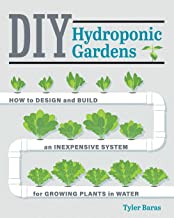
Tyler Baras’ book, DIY Hydroponic Gardens, provides information on choosing, building, planting and maintaining over a dozen hydroponic growing system so that plants can be grown anywhere. Written for beginners as well as experienced hydroponic gardeners, the book gives step by step directions for building systems that range from simple to complex so that gardeners can customize their system to meet their own special needs. Photographs and diagrams illustrate all aspects of building and maintaining the various systems so guess work is minimized.
After defining hydroponics and discussing its key features and advantages, Baras goes on to describe the needed equipment and gives suggestions for choosing the best options depending on the goals of the gardener. He then details the various hydroponic systems so that gardeners can tailor their system to their specific location, crop, and aesthetics. Included is bottle hydroponics, floating rafts, wicking bed, nutrient film technique, top drip system, media beds, flood and drain, aeroponics, and vertical gardens. For each system, the tools and material needed for assembly are listed, and detailed directions are given for building, feeding and aerating the system. Possible problems are discussed and options are described. An inset gives the suitable location, size potential, electrical requirements, and crops for which each system is best suited. Subsequent chapters deal with starting seeds and cuttings, nutrition and nutrient management, flushing and cleaning the system, and potential problems including pest infestations and nutrient deficiencies. A glossary and appendix giving crop selection charts complete the work. The glossary is especially noteworthy as it details the growing requirements for herbs, peppers, tomatoes, strawberries, and many different kinds of greens, with recommendations and comments on specific varieties/cultivars.
Although not a hydroponic gardener, I was impressed with the breadth of the content and found the information fascinating and informative. The list of materials and tools, plus the detailed photos of the building process allowed me to vicariously experience the creation of the various systems and gave me the confidence to think about trying some of the systems. My only criticism is the small gray print of the text. Why is this color print so popular when it is hard to read?
To buy DIY Hydroponic Gardens from Amazon, click here.